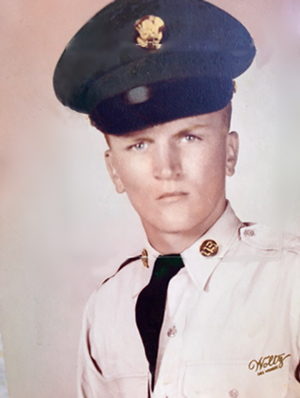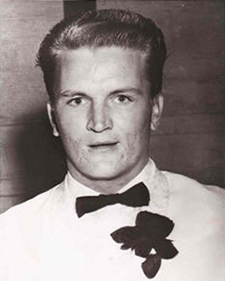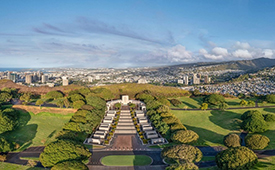Based on various records, Marshall (known as "Shorty" to his family) enlisted in the Air Force in 1961. As a munitions maintenance superintendent, he was assigned to the 4th Air Commando Squadron, 14th Air Commando Wing, 13th Air Force. On December 27, 1964, Airman First Class Pauley married Georgia Carol Geist in Lincoln, Nebraska. At the time of his death, he was in his second tour of duty in Vietnam.
The incident that took his life occurred on March 13, 1966, but A1c Pauley, who was promoted to chief master sergeant while in MIA status, was not declared dead until January 9, 1978, when it was determined that he most likely did not survive the incident. The Find A Grave Memorial for CMS Pauley, maintained by "Eddieb," adapted here, details the story of the operation in which he lost his life:
Chief Master Sergeant Pauley was a member of the 4th Air Commando Squadron, Da Nang Airbase, South Vietnam. On March 13, 1966, he was the aerial gunner of a Chinook Spooky Attack Aircraft Gunship I (AC-47D) on a night armed reconnaissance of Route 92 running through the dense jungle covered mountains of Quang Nam Province, South Vietnam. Radio contact was lost. His remains were not recovered. His name is inscribed on the Courts of the Missing at the Honolulu Memorial. . . .
On 9 March 1966, Capt. Howard W. Henninger, pilot Capt. Robert E. Pasekoff, co-pilot Capt. Gerald E. Olson, navigator TSgt. Edwin E. Morgan, loadmaster SSgt. Gene E. Davis, flight mechanic then SSgt. Marshall I. Pauley, aerial gunner and Sgt. Dean A. Duvall. . . comprised the crew of an AC47D gunship, call sign Spooky 73.
They departed Da Nang Airfield on an armed reconnaissance mission along Route 92 that ran through the dense jungle covered mountains of Quang Nam Province, South Vietnam.
The mission was scheduled to last 3 hours. Weather conditions were good. It was a moonlit night with scattered to broken clouds, smoke and haze.
Approximately 22 minutes after Spooky 73 took off, Capt. Henninger established radio contact with a standard communications check. At that time there was no indication of any trouble with the aircraft.
When Spooky 73 failed to return to base as scheduled, a ramp check of all bases that the AC47D could have diverted to was made. At 0800 hours the aircraft was declared overdue and initial search and rescue (SAR) operations initiated.
At 0740 hours on 14 March 1966, full SAR operations using 2 AIE and 1 HE16B aircraft combed the dense jungle covered mountains along Route 92 and their briefed flight path of Spooky 73.
This search effort was terminated at 1430 hours with no findings or sightings of the missing aircraft or its crew observed.
The last known location of Capt. Henninger's aircraft and crew placed them over rugged mountains covered in triple canopy jungle.
SAR operations continued on 15 March with two sorties of SAR aircraft dispatched to the area of the downed gunship. Beeper signals were heard by rescue personnel, however, the beeper signals were not of code and too short in duration to pinpoint their location.
Likewise, there was no way to determine which crewmen were attempting transmission.
All search efforts were terminated at 1730 hours with negative results.
At the time these efforts were terminated, Howard Henninger, Dean Duvall, Marshall Pauley, Robert Pasekoff, Gerald Olson, Edwin Morgan and Gene Davis were immediately listed Missing in Action. . . .
After the war, it was disclosed that Spooky 73 was on a secret mission over the Ho Chi Minh trail in Laos. In 1997 the crash site was discovered in Xekong Province, Laos. The site was extremely overgrown and degraded. Crews excavated the site from 2010 to 2014; some dog tags and other materials were found confirming it was the crash site of Spooky 73. It is not known if the plane crashed or was shot down, nor if the crash was survivable. One airman's remains have been identified and returned to the United States—Chief Master Sergeant Edwin E. Morgan.
West Virginia Archives and History welcomes any additional information that can be
provided about these veterans, including photographs, family names, letters and other relevant
personal history.




